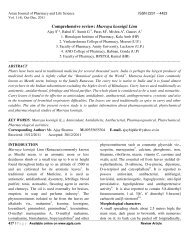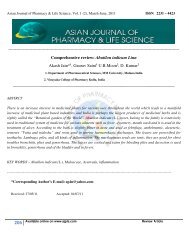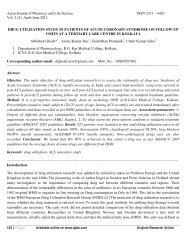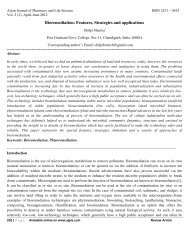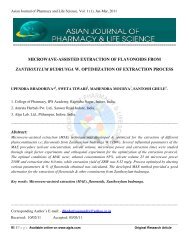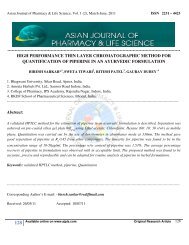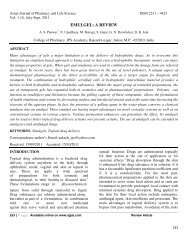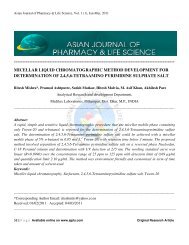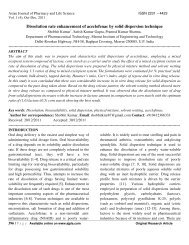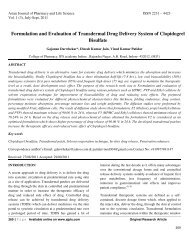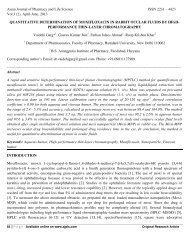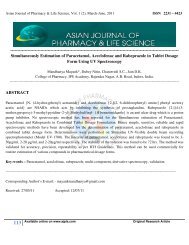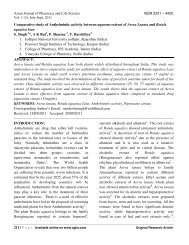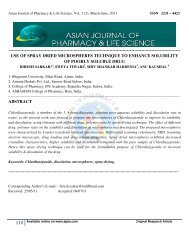antipyretic and phytochemical evaluation of the ethanol
antipyretic and phytochemical evaluation of the ethanol
antipyretic and phytochemical evaluation of the ethanol
You also want an ePaper? Increase the reach of your titles
YUMPU automatically turns print PDFs into web optimized ePapers that Google loves.
Asian Journal <strong>of</strong> Pharmacy <strong>and</strong> Life Science ISSN 2231 – 4423<br />
Vol. 2 (2), April-June,2012<br />
Test for tannins<br />
About 1g <strong>of</strong> <strong>the</strong> powdered material was boiled with 20 ml <strong>of</strong> water, filtered <strong>and</strong> used for <strong>the</strong> following test.<br />
Ferric Chloride Test - To 3 ml <strong>of</strong> <strong>the</strong> filtrate few drops <strong>of</strong> Ferric chloride were added .A greenish black<br />
precipitate indicated <strong>the</strong> presence <strong>of</strong> tannins.<br />
Test for flavonoids<br />
About 10 ml <strong>of</strong> ethyl acetate was added to 0.2g <strong>of</strong> <strong>the</strong> extract <strong>and</strong> heated on water bath for 3 minutes. The mixture<br />
was cooled, filtered <strong>and</strong> used for <strong>the</strong> following test<br />
Ammonium Test<br />
About 4 ml <strong>of</strong> <strong>the</strong> filtrate was shaken with 1 ml <strong>of</strong> dilute ammonia solution. The layers were allowed to separate<br />
<strong>and</strong> <strong>the</strong> yellow colour in <strong>the</strong> ammoniacal layer indicated <strong>the</strong> presence <strong>of</strong> Flavonoids.<br />
1%Aluminium Chloride Test<br />
Ano<strong>the</strong>r 4 ml <strong>of</strong> <strong>the</strong> filtrate was shaken with 1 ml <strong>of</strong> 1% Aluminum Chloride solution. The layers were allowed to<br />
separate. A yellow colour in aluminum chloride layer indicates <strong>the</strong> presence <strong>of</strong> Flavonoids.<br />
Test for resins<br />
About 0.2 g <strong>of</strong> <strong>the</strong> extract was shaken with 15 ml <strong>of</strong> 96% <strong>ethanol</strong>. The alcoholic extract was <strong>the</strong>n poured into 20 ml<br />
<strong>of</strong> distilled water in a beaker. A precipitate occurrence indicates <strong>the</strong> presence <strong>of</strong> resins.<br />
Colour Test<br />
About 0.2 g <strong>of</strong> <strong>the</strong> extract was extracted with chlor<strong>of</strong>orm <strong>and</strong> <strong>the</strong> extract was concentrated to dryness. The residue<br />
was redissolved in 3 ml <strong>of</strong> acetone <strong>and</strong> ano<strong>the</strong>r 3 ml <strong>of</strong> conc. HCL acid was added .The mixture was heated in a<br />
water bath for 30 minutes. A pink colour which changes to magenta red indicates presence <strong>of</strong> resins.<br />
Test for steroids <strong>and</strong> triterpenoids<br />
About 9 ml <strong>of</strong> <strong>ethanol</strong> was added to 1 g <strong>of</strong> <strong>the</strong> extract it was refluxed for a few minutes <strong>and</strong> filtered. The filtrate was<br />
concentrated on a boiling water bath. 5 ml <strong>of</strong> hot distilled water was added to <strong>the</strong> concentrated solution, <strong>the</strong> mixture<br />
was allowed to st<strong>and</strong> for 1 hour <strong>and</strong> <strong>the</strong> waxy matter was filtered <strong>of</strong>f. The filtrate was extracted with 2.5 ml <strong>of</strong><br />
chlor<strong>of</strong>orm using separating funnel. To 0.5 ml <strong>of</strong> <strong>the</strong> chlor<strong>of</strong>orm extract in a test tube was carefully added 1 ml <strong>of</strong><br />
conc. H 2 SO 4 to form a lower layer. A reddish brown interface shows <strong>the</strong> presence <strong>of</strong> steroids. 0.5 ml <strong>of</strong> <strong>the</strong><br />
chlor<strong>of</strong>orm was evaporated to dryness on a water bath <strong>and</strong> heated with 3 ml <strong>of</strong> <strong>the</strong> concentrated sulphuric acid for<br />
10 minutes on a water bath. A grey colour indicates <strong>the</strong> presence <strong>of</strong> terpenoids.<br />
139 | P a g e Available online on www.ajpls.com Original Research Article



